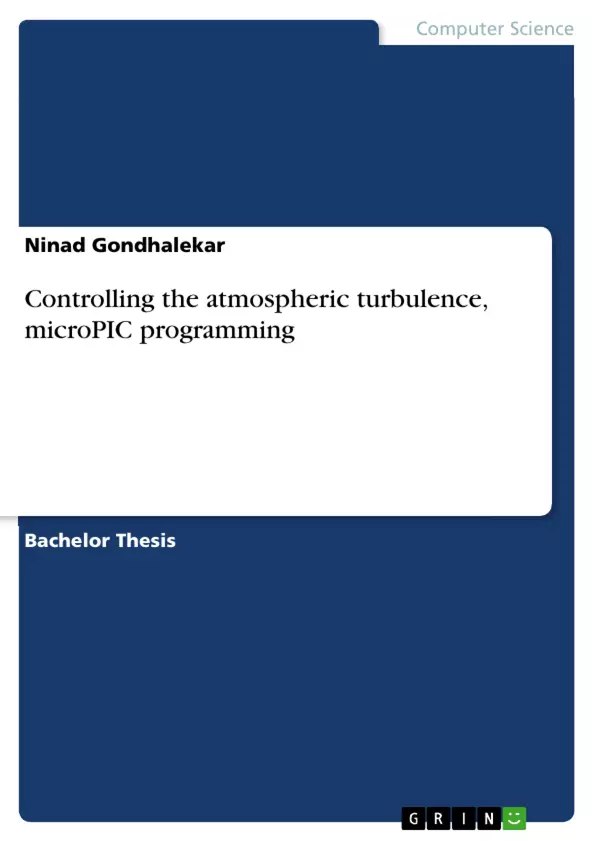Chamber is used to study atmospheric turbulence effects on FSO signals and this experiment is done inside the laboratory to avoid the interference of sunlight light and also it is hard to create turbulence outside laboratory as outside temperature and pressure will affect the turbulence created inside this chamber. This project is all about controlling all parameters (temperature, pressure, humidity) using sensors, fans, thermistors through embedded circuit.
As observed from previous work, high end microPIC (PIC18 series) although it has many functionality and large program memory size, it is hard to control all sensors, fans, thermistor using 1 PIC1866K80, So in this project mid-range PIC (PIC16 series) are used to control sensors, fans and thermistors.
In this project, temperature, humidity, pressure sensors are controlled by different microcontrollers and taking their reading to manage the performance of PWM fans and thermistors inside the chamber. These components are very important to configure and monitor the atmospheric condition inside the chamber.
This project focuses on the use of PIC16 family microcontrollers to be programmed in C language or in assembly to control all sensors, fans and thermistor and build PCB layout.
In this project, Rs-232 or Com port will be used as an interface to control the PIC16 microcontroller instruction and procedure through computer.
Inhaltsverzeichnis (Table of Contents)
- Abstract
- Acknowledgement
- Introduction
- Previous Work
- Motivation
- Literature review
- Free Space Optical Communication
- Advantages and Disadvantages of FSO
- FSO System
- Effects of Atmospheric Attenuation of FSO Communication
- Performances of FSO Links
- Aim and Objectives
- Temperature Sensors
- Working of DS18B20 temperature sensor
- Power supply for DS18B20
- Memory of DS18B20
- DS18B20 Sequence
- Coding for PIC16F627A and DS18B20 in C language
- Arduino Program for more than 1 DS18B20 temperature sensors
- PCB and schematic diagram
- Humidity Sensor
- Working of SHT11
- Communicating with SHT11 humidity sensor
- Calculating relative humidity
- Coding for PIC16F627A and SHT11 humidity sensor
- Arduino Program for SHT11 sensor
- PCB and schematic diagram for SHT11
- Pressure Sensor
- Working of MPX4115a pressure sensor
- Calculating pressure
- Coding for PIC16F627A and MPX4115a pressure sensor
- Arduino Code for MPX4115a
- PCB and Schematic Diagram for MPX4115a pressure sensor
- Results and Discussion
- Conclusion and Further Work
Zielsetzung und Themenschwerpunkte (Objectives and Key Themes)
This project focuses on controlling the atmospheric turbulence within a chamber to study its effects on free space optical (FSO) signals. The main goal is to achieve this control by managing critical parameters like temperature, humidity, and pressure using sensors, fans, and thermistors. The project emphasizes the utilization of mid-range PIC microcontrollers for controlling these elements, emphasizing the use of C language for programming. Key themes include: * **Free Space Optical Communication (FSO):** The project investigates the influence of atmospheric turbulence on FSO signals, a crucial aspect of wireless communication. * **Atmospheric Turbulence Control:** The work focuses on replicating realistic atmospheric conditions within a controlled chamber environment. * **Microcontroller Programming:** The project utilizes PIC microcontrollers for controlling various sensors and actuators to precisely manipulate the chamber's environment. * **Embedded Systems Design:** The research involves designing and implementing embedded circuits to achieve real-time control of the chamber's atmospheric parameters.Zusammenfassung der Kapitel (Chapter Summaries)
* **Introduction:** This section provides a background on the project and its relationship to the Northumbria Communication Research group's ongoing research on FSO communication. It highlights the existing chamber setup and the need for an upgrade to improve the control of atmospheric variables. * **Previous Work:** This chapter outlines a previous project on the impact of sandstorms on FSO communication, detailing the methods employed and the challenges encountered. * **Motivation:** The motivation behind the current project is clearly stated - to create a controlled environment that replicates atmospheric turbulence to enable detailed study of its effects on FSO signals. * **Literature review:** This comprehensive section delves into the theoretical underpinnings of FSO communication. It covers aspects like FSO system components (transmitter, channel, receiver), advantages and disadvantages of FSO technology, and the impact of atmospheric attenuation on FSO signals. It also explores the effects of turbulence and the use of various sensors to measure atmospheric parameters. * **Aim and Objectives:** The project's aim and specific objectives are clearly articulated. The objectives include researching and programming microcontrollers to control temperature, humidity, and pressure sensors, as well as managing PWM fans and thermistors within the chamber. * **Temperature Sensors:** This section examines the DS18B20 temperature sensor in detail, including its functionality, power modes, memory organization, and communication sequence. It also presents C code developed for the PIC16F627A microcontroller to interface with the sensor and Arduino programs for multiple sensor configurations. * **Humidity Sensor:** This chapter focuses on the SHT11 humidity sensor, outlining its working principles, communication protocol, and calculation of relative humidity. It also includes C code for interfacing the sensor with the PIC16F627A and Arduino programs for controlling the sensor. * **Pressure Sensor:** This chapter focuses on the MPX4115a pressure sensor, explaining its functionality, pressure calculation methods, and C code for interfacing with the PIC16F627A. It also includes Arduino programs for controlling the pressure sensor.Schlüsselwörter (Keywords)
This project centers around the control of atmospheric turbulence for investigating its impact on Free Space Optical (FSO) communication. Key terms include: FSO, atmospheric turbulence, chamber control, PIC microcontrollers, temperature sensors, humidity sensors, pressure sensors, PWM fans, thermistors, embedded systems, C programming, and Arduino. The project leverages both experimental and computational approaches to develop a robust and reliable system for replicating and controlling atmospheric conditions to study their influence on FSO signal propagation.- Citation du texte
- Ninad Gondhalekar (Auteur), 2013, Controlling the atmospheric turbulence, microPIC programming, Munich, GRIN Verlag, https://www.grin.com/document/284209



